In its three hundred plus years, Belle Grove Plantation has stood witness to many of America’s greatest historic events and hosted many famous and historical people. Its history includes being among the sites of England’s first colonization efforts in the New World in the late 1600’s to the American Revolution to the American Civil War. Come discover Belle Grove Plantation’s rich history and the people who helped forge a nation at this Southern Plantation.
On September 28th, 1667, Governor Sir William Berkeley, granted a land grant to Thomas Chetwood and John Prosser for 5,275 acres known as “Nauzem”. This was in consideration for having transferred 106 persons from England to the New Colonies.
On April 13, 1670, John Prossor sold 1000 acres known as “Mangecemuzen” or “Mongoheocala” to Anthony Savage. Anthony Savage (? – June 5, 1695) was the son of John Savage of Castleton, Derbyshire. Anthony Savage was a Justice in two counties and was a Captain of Militia. The title of “Captain” was one of courtesy only and was bestowed to him posthumously.
Anthony Savage was married to Alice Stafford Savage (?- before 1701) and moved to his new property with his daughter Alice Savage. Just next door was the plantation that would become known as Millbank. It had been purchase just six months before by William Strother and his wife Dorothy Savage Strother (1635-1702). Dorothy was the daughter of Anthony and Alice. William and Dorothy would have six children.
Anthony Savage’s other daughter, Alice (1653-1692) would marry Francis Thornton (1651-1726/27). They would have seven children. Their first daughter, Margaret would marry her first cousin William Strother II. Margaret and William had been childhood friends and one of their friends was Lawrence Washington, Great Grandfather of George Washington. Lawrence Washington was born and raised at Mattox Creek just nine miles away from Belle Grove.
When Anthony Savage died, he passed 700 acres of his property to Francis and Alice Thornton. He would pass 300 of the property to Margaret and William. This 300 acres would become part of Millbank.
Francis and Alice Thornton also had another daughter, Elizabeth Thornton (1673/74-1732) who would marry Edwin Conway (1653-1698). Edwin and Elizabeth would have only one child, Francis Conway (1696-1736). Edwin would die just two years later. Elizabeth would marry Jonathan Gibson(1672-1729) and have two more children. At the death of her father, Elizabeth and Jonathan would inherit the 700 acres. Jonathan would die just three years later.
At the death of Jonathan Gibson, Francis Conway I and his wife Rebecca Catlett Conway (1702-1761) would inherit the 700 acres. Francis and Rebecca would have six children. One of those children was Eleanor Rose Conway (1730/31-1829). Nelly as she was known by would meet her future husband, James Madison Sr. (1732-1801) when he came to Port Royal to ship his crop of tobacco. Nelly would return to her mother’s property in December, 1750, pregnant with her first child. On March 16, 1751, Nelly gave birth to James Madison Jr. in her mother’s home at Belle Grove. James Madison Jr, also known as Jemmy would become the 4th President of the United States.
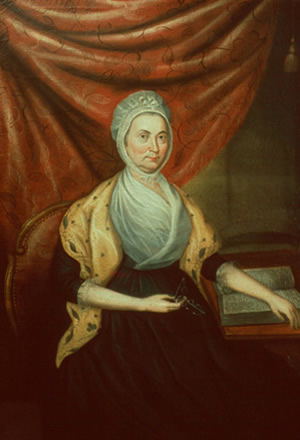
Nelly Conway Madison
By Charles Peale Polke, 1799
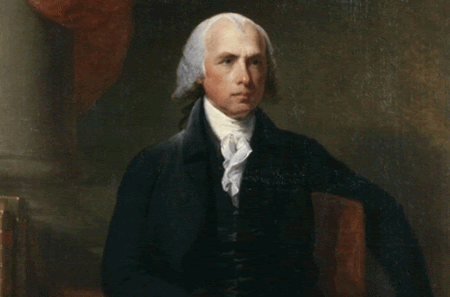
James Madison
By Gilbert Stuart 1805-1807
Francis Conway I and Rebecca Catlett Conway also had a son, Francis Conway II (1722-1761). He would marry Sarah Taliaferro (1727-1784) and have three children. At the death of Francis Conway I, Rebecca would marry John Moore (1698-1759). John and Rebecca would have two children. Francis Conway II would inherit the property at the death of his father, Francis Conway I. Because Francis Conway II was just 14 at the time of his father’s death, Rebecca would remain on the property with her husband John.
It is believed that some time, shortly after the birth of James Madison Jr., Rebecca and John’s home burn to the ground. They would move to Port Royal to what is now known as the Bowie House which was built in 1740 by James Bowie, the owner and operator of the ferry between Port Royal and what would become Port Conway. They would later return to Belle Grove where they would both live until their deaths. It is believe at this time, Belle Grove Plantation received its name from John Moore.
Francis Conway II would die in 1761 and Sarah would marry George Taylor (1710/11-1792). They would have five children. Francis Conway II and Sarah’s oldest child, Francis Conway III (1748/49-1794) would marry Elizabeth Fitzhugh (1754-1823). They would have six children. Francis Conway III would serve in the local Militia during the American Revolutionary War and be awarded the rank of Captain.

Elizabeth Fitzhugh Conway 1754-1823
By Virginia Historic Society
After the death of his mother, Sarah in 1784, Captain Francis Conway would pull 20 half-acre lots from the Belle Grove property to form the village of Port Conway. Port Conway had a wharf and post office.
On April 3, 1790, Captain Francis Conway sold Belle Grove Plantation to John Hipkins (1747-1804) of Port Royal for 2,000 pounds. Captain Conway and his wife would move to Mt. Scion. There Captain Conway would pass away just four years later.
One final note:
Captain Conway and his wife, Elizabeth’s first child, Francis Fitzhugh Conway was involved in a duel with his cousin William Thornton in 1803. While visiting Chatham Manor in December, 1803, Francis and William both had their eyes on Nelly Madison, daughter of Ambrose Madison, brother of James Madison. William Thornton had come from the family of Rowland Thornton, brother of Margaret and Elizabeth Thornton. Trying to impress Nelly, Francis had purchased a special saddle (or could have been a bridle) for his horse and had paid the groomsman to place it on his horse before bring the horse around to leave. But when Francis’s horse came around, the saddle wasn’t on his horse. It was on that of William Thornton, his rival. Upset and embarrassed, he challenged William to a dual at Alum Springs.
There they met and there they shot each other with pistols that were later throw into the pond. It is believed that Francis died short after the dual, but William managed to get back home, only to die two days later. Nelly Madison would later marry Dr. Willis and would be present at the death of President James Madison. If you visit Alum Springs today, you can still see where they fought. It is said that Elizabeth Conway, Francis’s mother had a dream of her son’s death only to wake the next morning with the news.
On April 3, 1790, John Hipkins (1754-1804) purchased Belle Grove Plantation from Captain Francis Conway for 2,000 pounds. John Hipkins was the son of Samuel and Margaret Upshaw Hipkins of Essex County. John married Elizabeth Pratt (1754-1829), daughter of Thomas and Margaret Pratt. John and Elizabeth were married in the early 1770’s. John and Elizabeth lived the early part of the marriage in King and Queen County and seemed to have moved to Caroline County, which is the county just across the river from Belle Grove in December, 1778, when his name appeared on the roster of the Port Royal Kilwinnig-Crosse Lodge #2. Three years later his name appeared on a deed and the tax records for 1782 listed him as a resident of the county and the owner of eight slaves. John served as Magistrate in King and Queen County. He took the oath of Sheriff of Caroline County on November 9, 1802.
On May 14, 1775, Francis “Fanny” Hipkins was born the John and Elizabeth. She would be their only surviving child. Fanny’s parents, most especially her father, spared nothing for her. John even had one of his ships named after her. This ship would later be captured by pirates and lost along with its cargo and crew.

Francis “Fanny” Hipkins Bernard
We have uncovered a portrait of Fanny. This portrait comes from a collection at the Virginia Historic Society. In it you can see that they spared no expense for her with her strings of pearls, earrings, lace, feathers and miniatures on gold chains.
Fanny Hipkins (1775-1801) would marry William Bernard (1770-1841)of King George County on April 9, 1789, one month prior to her fourteenth birthday. William would turn nineteen that September.
Shortly after the marriage John would take William into partnership, establishing the firm Hipkins & Bernard, in order to improve him (Bernard) and to keep him employed. William did not take stock in the business, being just eighteen and the business was conducted on John’s capital. This arrangement lasted for two years when on September 1, 1791; it reverted back to John Hipkins & Company. John thought that if storekeeping wasn’t for William, maybe farming would suit him better. So John bought Belle Grove Plantation from Francis Conway, in 1790 with the thought of giving it to his daughter and son-in-law. John then built the center section of the house that currently stands at Belle Grove for William and Fanny, which they moved into in 1791. John sold Belle Grove to William for a sum of five shillings.
Here is one small note about Belle Grove and Rose Hill (home of John and Elizabeth Hipkins) Plantations. In the fall and winter months, if you stand on the River side of Belle Grove, you can see the house at Rose Hill up on a hill across the river. Maybe John wanted to keep an eye on his only daughter.
When Fanny and William moved into Belle Grove, they already had a daughter, Sarah “Sallie” Salvin Bernard, who was born at Rose Hill in 1790. She would be followed by three more siblings, John Hipkins Bernard (1792-1858), Elizabeth “Eliza” Bernard (1794-1803) and William Bernard (1796-1822). While living at Belle Grove Plantation, William purchase six of the half-acre lots of Port Conway and started the process of folding this property back into Belle Grove.
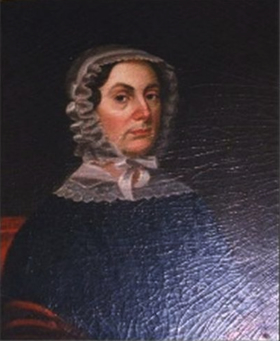
Sarah “Sallie” Salvin Bernard 1790
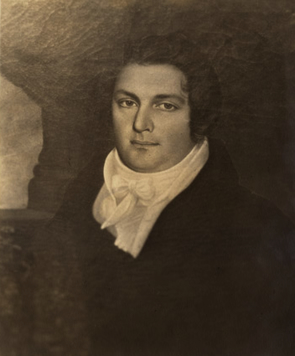
William Bernard 1796-1822
Virginia Historic Society
In April, 1800, a second partnership was attempted, this time the firm was William Bernard & Company. This formation was in order for John to retire from active business.
On April 30, 1801, Fanny passed away, leaving William with four children, a large plantation and a business to run. Fanny was buried on the property of Belle Grove in “mother’s garden”. On July 6, 1803, Eliza Bernard passed away and was placed with her mother in the garden.
This business continued along the same pattern as the first partnership with John being the most active. By 1803, William again withdrew his whole attention from the business. John and William spent most of the rest of John’s life in court, trying to settle the estate and business issues.
John Hipkins passed away in 1804. He was buried next to his daughter and granddaughter on the property of Belle Grove. His plantation, Rose Hill was passed to his grandson and name sake, John Hipkins Bernard. Being that John Hipkins Bernard was only twelve at the time, his grandmother, Elizabeth Pratt Hipkins, held the property in trust for him.
William Bernard would marry a second time to Elizabeth Hooe in 1804. He would also move the family from Belle Grove Plantation to a new plantation in Stafford County, Virginia, called Mansfield. Belle Grove would be leased until William Bernard II given it in 1819.
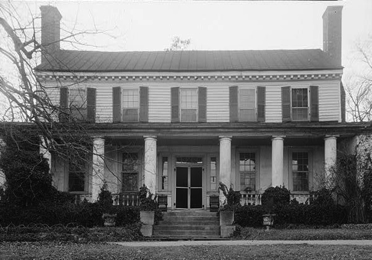
Rose Hill Plantation aka Gaymont
Library of Congress
John Hipkins Bernard inherited Rose Hill Plantation upon the death of his grandmother Elizabeth Pratt Hipkins in 1829. Elizabeth joined her husband, daughter and granddaughter at Belle Grove. John Hipkins Bernard would marry Jane Gay Robinson. He would change the name from Rose Hill to Gaymont in her honor. The home was known as Gaymont until the current owner changed the name back to Rose Hill Plantation.
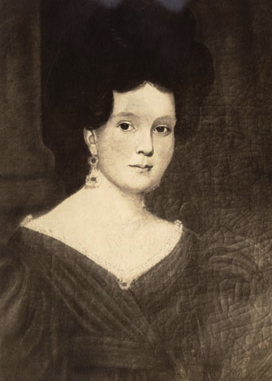
Sarah Dykes
William Bernard II would marry Sarah Dykes and have two surviving daughters, Eliza Bernard (1815) and Sarah Ann Bernard (1817). William and Sarah had a total of seven children, with two sets of twins. Five of those children, including the two sets of twins would pass away as infants. These infants were buried with William’s mother, sister and grandfather at Belle Grove.
William Bernard II passed away on January 31, 1822 and was also buried at Belle Grove. With his sudden death and no will, William Bernard I stepped in as guardian of the two infant children and daughter-in-law. He would manage the estate until 1839. On December 11, 1839, William sold Belle Grove to the husbands of Eliza and Sarah Bernard for one dollar. Sixteen days later, Belle Grove was sold to the Turner Family. Sarah Dykes Bernard moved and later pass away in 1860. She was not buried with William.
The Turner Family dates back to Thomas Turner, who first appeared in the records on February 14, 1725 when he purchased 200 acres in Hanover Parish. He would continue to purchase parcels and by 1753 he had amassed 2300 acres, which he named Walsingham. This plantation is next door to Belle Grove on the opposite side of the present day Route 301. It is unclear just when Thomas Turner arrived in Virginia.
Thomas married twice in his lifetime. Both of his wives, Martha and Sarah were the daughters of Richard Taliaferro, who lived in Caroline County at Taliaferro Mount. Richard Taliaferro was a ship’s Captain. His wife, Sarah Wingfield was from Barbados. Together Richard and Sarah had four children.
Thomas married Martha in 1714 and they had two sons, Harry and Thomas II. Harry Turner married Elizabeth Smith of Smith’s Mount, near Leedstown, Virginia and they had one son, Thomas Turner III. Thomas Turner III married Jane Fauntleroy of Naylor’s Hole and they had seven children.
Thomas Turner III would inherit Smith’s Mount from his mother and Walsingham from his father. He would then add another 2400 acres plantation called Nanzatico, which is next door to the Walsingham plantation. The Nanzatico Plantation’s home had been built by Charles Carter in 1769. At the death of Thomas Turner III, his three sons would divide his property. Richard Turner would inherit the Walsingham Plantation. George Turner would inherit the Nanzatico Plantation. Thomas Turner IV would inherit the Oaken Brow Plantation, which was originally part of the Nanzatico Plantation.
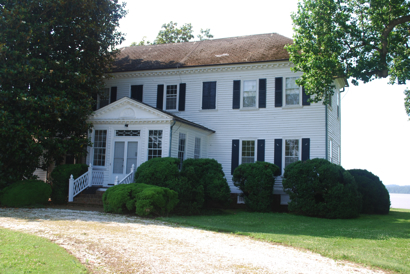
Nanzatico Plantation
George Turner would marry Caroline Matilda Pratt, who was the daughter of John Birkett and Alice Fitzhugh Dixon Pratt of the Camden Plantation, across the Rappahannock River from Nanzatico Plantation. Their youngest son was Carolinus Turner. When his mother was pregnant with Carolinus, the Turner’s had already had two sons and were sure that Carolinus was going to be a girl. They had selected the name Caroline, which is a family name. To their surprise, their new daughter turned out to be a new son. So they named him Carolinus.
On December 27, 1839, Carolinus purchase Belle Grove Plantation from John A. Meredith and his wife Sarah Bernard Meredith and Thomas Semmes and his wife Eliza Bernard Semmes for the sum of $11,000 cash in hand. Carolinus Turner would take this modest Federal style home and convert it into a Greek Revival style home. If you look at the old photos of Rose Hill Plantation (also known as Gaymont Plantation), which was built by John Hipkins (also who built the original Belle Grove home) in the 1790s, you can image what Belle Grove Plantation started out as. Carolinus would extend the sides and add a small extension on the second floor of the extensions. He would add the porticos that stand out from the house on both the Plantation and Riverside. He would add the curved porches on the Plantation side with circular steps at the front and two side doors. The circular steps in front and the scrolled steps on the Riverside of the home were thought to have been purchased and made in England. He would add the architectural details all along the roof line as well as on the exterior walls.
He would also make changes to the town of Port Conway. On May 6, 1859, he set aside a one acre lot that he donated to the local parish for use as an Episcopal Church. This church would become Emmanuel Episcopal Church, which is still in use today. He would also start acquiring the half acre lots of Port Conway and would fold them back into the Belle Grove Plantation.
In 1847, Carolinus married Susan Augusta Rose at Belle Grove Plantation. They would have five children, Caroline “Carrie” Turner, Anna Augusta Turner, George Turner, Susan Rose Turner, and Alice Pratt Turner.
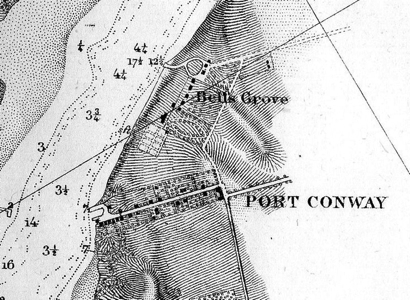
1856 Map – Note the Slave Quarters
In 1861, Carolinus Turner was a wealthy farmer with 92 slaves. At 48, he had a young family with wife, and a live-in teacher, Mary Morrison, 23. His assets were listed in the 1860 Federal Census as being $272,500.00 in property. But things would change with the coming of the Civil War.
The area around Belle Grove Plantation would become very important during the Civil War. On the east side of the Rappahannock River, there were several plantations including Nazatico, Woodlawn, Oaken Brow, Walsingham, Belle Grove and Millbank that lined the river. On the west side of the Rappahnnock, there were other plantations such as Camden, Gaymont (known as Rose Hill today) and Hazelwood, along with the port city of Port Royal. While these plantations were productive farms, it was the port of Port Royal and its location on the Rappahannock River that would be its greatest asset.
The Rappahannock River in most areas is quite wide, but here between Port Royal and Port Conway, the river narrows, making it an ideal location for crossing for main road ways that had been in use since the late 1600s. Port Royal and Port Conway are also just 20 miles from Fredericksburg.
At the start of the war in 1861, the residents around this area would join the Confederate cause. Most men would enlist with the 9th Virginia Cavalry, the 47th Virginia Infantry or the Caroline Light Artillery. In the 47th Virginia Infantry, they would have been part of Company E and would have been called Port Royal Guards. They would report to Fredericksburg in June, 1861. The Caroline Light Artillery formed in July, 1861 and the 9th Virginia Cavalry would form in January, 1862. Most of these men would fight just within 75 miles of their homes.
Between April, 1862 and August, 1862, Union Forces occupied Fredericksburg. It was in August that Acting Master Nelson Provost, commander of the steamer USS Anacostia conducted a two day expedition from Fredericksburg to Port Royal. He reported to General Ambrose Burnside that he and his crew, along with 25 men of the 9th New York Infantry had progressed down the river towards Port Royal because of reports of communications coming from Port Royal Confederates to both Baltimore and Richmond.
In his report, informants had told of new recruits for the Confederate Army had been ferried across the river from Port Conway to Port Royal with supplies. They would then make their way to Richmond. In this expedition, the Union detachment captured prisoners, destroyed several boats, including the ferry at Port Conway. In December, 1862, four gunboats were sent to Port Royal to support General Burnside’s campaign in Fredericksburg. These gunboats were under the command of Commander Samuel Magaw. General Daniel Harvey Hill and General Rooney Lee defended Port Royal. The Union fleet was forced back down river.
Just a few short days later, the Union Navy started shelling Port Royal to diverted attention from Fredericksburg. This attack lasted two days. The Confederate army held the Union navy at bay until General Hill was called to Fredericksburg. Two days later, General Magaw gave the Confederate army an ultimatum; either evacuate Port Royal or the town would be destroyed. Lt. Colonel Zachariah of the 10th Virginia Cavalry notified the civilian population of Port Royal to evacuate. On hearing the news, General Lee came to Port Royal’s defense and sent troops back to Port Royal. By this time, General Burnside had withdrawn from Fredericksburg so General Magaw did not go through with the mission. Port Royal was saved.
General Robert E. Lee was born not too far from Port Conway and Port Royal at Stratford Hall. During the Civil War, he would have his wife’s cousin, Julia Stuart, wife of Doctor Richard Stuart of Cleydael, to keep his two daughters’ through most of the Civil War. Cleydael is just nine miles from Belle Grove Plantation.
Helen Bernard of Gaymont (known as Rose Hill today), daughter of John Hipkins Bernard and his wife Jane Bernard witnessed and wrote about her days during the Civil War. You might remember that John Hipkins Bernard was grandson of John Hipkins, the man that built the current center section of Belle Grove for his daughter, Fannie. Helen Bernard would write of dinners at Gaymont with Confederate officers General JEB Stuart and General Rooney Lee. She would also write about a raid that the Union army made on Port Royal in April, 1863. She would tell of five hundred Yankees pillaging the village, only to leave before the Confederate army arrived.
In August, 1863, two gunboats, the Satellite and the Reliance were captured by the Confederate army and were kept at Port Conway. In September, Brig. General Judson Kilpatrick and his Union forces were sent to Port Conway to recapture or destroy these gunboats. He advanced from King George using three roads, forcing the Confederate forces to move across the river to Port Royal. Early the next morning, Captain S.S. Elder of Battery E, 4th U.S. artillery planted his guns just above and just below the gunboats and opened fire at a range of 700 yards, driving the Confederate forces from the boats. Two hours later, the Satellite was heavily damaged and started to sink. All weapons were fixed then on the Reliance. After another three hours, Brig. General Kilpatrick withdrew and moved to Lamb’s Creek Church, where he had a small fight with some Confederate forces. Afterward he made camp there. The Confederate army took advantage of this and stripped the gunboat of its machinery and guns. The gunboats were too damaged to save. One note; ironclads had been called to use during this fight, but had failed to show. Brig. General Kilpatrick reported only three killed and three wounded. There is no mention of a report from the Confederate forces.
By May, 1864, the Union army had control of Port Royal and made it a supply depot. Helen Bernard would write about General John Abercrombie of the Union army sending a guard to protect her family and remaining slaves. Instead the Union soldiers would take their mules and kill the remaining foals.
The soldiers from Port Royal and surrounding areas would see many from its ranks lost. The 9th Virginia Cavalry started with 1,815, but would be down to just 522 by the time they moved to Gettysburg. At the surrender at Appomattox, they would surrender 27 men, just one officer and 26 men. The 47th Virginia Infantry would start with 1,172 men. By April, 1862 it would be down to just 444 men. At Appomattox, they would surrender just two men. The Caroline Artillery start with 243 men and at Appomattox, they would surrender one officer and 11 men.
As for the Turner Family, we know that Carolinus was involved with the war and was part of the Confederate cause because we have located his pardon issued by President Andrew Johnson. We have a copy of this pardon, but the original is housed in the library in King George, Virginia. We also know that he was part of the Memorial Association of the Confederate. We believe that the Turners were forced out of Belle Grove Plantation during the war.
In the 1870 Federal Census, Carolinus Turner was still listed as a farmer. At the age of 57, his wealth dropped from $272,500.00 at the start of the war to $110,000 at the end in 1870. His family Susan, 33, Carrie, 22, George, 17, Susan, 15 and Alice, 14 lived in Chotank.
You have to wonder what this family saw and what they endured during this war. It was just at their door step. Most girls were married by the time they were 22, but Carrie would not marry for another six years. It is no wonder with the loss of men from this area during the war.
But Carrie must have had a beau in 1869. In the Turner Room on the second floor of Belle Grove’s Mansion, there is an etching in the window that says:
Carrie Turner
M (or W) Vanderburgh
May 18, 1869
We do know that Carrie married Dr. William Newton Jett in 1872. But we are unsure who Mr. Vanderburgh was. Could he have been a Union Soldier she met during the war? Did he die? Did they end the relationship before the marriage? We do not know.
We have yet to confirm Belle Grove served as a headquarters. What we do know is that during the restoration from 1997 to 2003, no bullet holes or scars from being fired on were found. We hope as we continue our research, we will be able to confirm its use during the Civil War.
After the war, Carolinus Turner sent a letter requesting amnesty to President Johnson for his role in the Civil War. From this letter we found out that Carolinus Turner’s wife, Susan August Rose Turner had an uncle, Captain William Jameson that had served in the U.S. Navy during the war. She also had two brothers that served in the Civil War, Alexander Rose, her older brother and Dr. William Rose, her younger brother. Both served in the war and both were killed. We haven’t been able to find out which side they served on.
Carrie Turner would marry Dr. William N. Jett in 1874. Dr. Jett was a widower with six children from his first wife, Virginia Mitchell. Dr. Jett and Carrie would have their own child, George Turner Jett in 1876. Dr. Jett, Carrie and Virginia Mitchell and three of Dr. Jett’s and Virginia’s children are buried at Emmanuel Episcopal Church located just as you enter Belle Grove Plantation.
Anna Turner would marry Captain Robert L. Robb in 1869. They would have five children. Here is a note on Robert Robb. His mother, Frances Bernard Lightfoot was the daughter of Sarah “Sallie” Bernard Lightfoot, daughter of Frances Hipkins Bernard for whom the current mansion at Belle Grove was built for. One of their children, Carolinus Turner Robb would pass away just under two years old. Anna Turner Robb is also buried at Emmanuel Episcopal Church.
George Turner would marry Jane Murphy McGuire in 1876. They would have nine children. George and Jane are also buried at Emmanuel Episcopal Church along with their son Edward McGuire Turner and daughter Susan Rose Carter Turner Mitchell.
Alice Pratt Turner would marry George B. Matthews in 1875. They would have one daughter, Alice T. Matthews.
Susan Rose Turner would marry Frederick Campbell Stewart Hunter in 1874. Frederick was a lawyer in King George and would go on to become a county judge in 1880s. They would have three children, son Frederick Campbell Stewart Hunter, daughter Caroline C. Hunter and son Thomas Lomax Hunter. Thomas would grow up to do some wonderful things in his life. He would attend William and Mary College in Williamsburg and Georgetown University. In 1908 he would pass the Virginia bar and work as a lawyer in King George, Virginia. In 1929, he started writing a column for the Richmond Times-Dispatch called “As It Appears to the Cavalier”. He would write this column until his death in 1948. He also published a book called “Columns from the Cavalier” in 1935. He would serve as a delegate in the Virginia House of Delegates for King George from 1918 to 1920. During World War I, he would serve as a food administrator for King George. He was given the honor as Poet Laureate of Virginia in 1948.
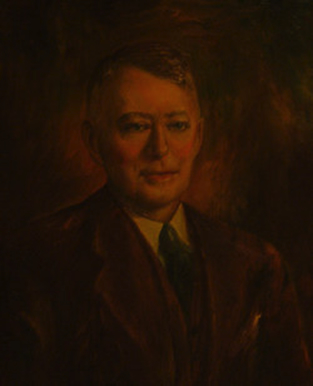
Thomas Lomax Hunter
Poet Laureate of Virginia in 1948
All three of Susan and Frederick’s children were born at Belle Grove Plantation. None of the Hunter family is buried at Emmanuel Episcopal Church.
In 1876, Carolinus Turner would pass away at the age of 64. He would pass away from consumption. Consumption is just another term for tuberculosis. Carolinus Turner’s obituary that appeared in the Alexandria Gazette on December 19, 1876 that was reprinted from the Fredericksburg Herald:
“DEATH OF A PROMINENT CITIZEN OF KING GEORGE –
The many friends of Carolinus Turner, of King George Co., will regret to learn of his death, which occurred on Monday last at his home in that county. Mr. Turner was a large landholder, and previous to the war, owned a great many servants. He was a gentleman of excellent education, and commanded the respect and esteem of a large circle of friends.”
After the death of Carolinus Turner, it seems that Susan, his wife moved from Belle Grove to one of their other properties. From a Federal Census in 1880, I found her living alone as a widow in King George with just one laborer and one servant.
At his death, Carolinus was buried at Emmanuel Episcopal Church. The land for this church was donated in 1860 by Carolinus. Just in front of his grave is also the grave of Susan Turner’s mother, Anna August Rose who passed away in 1853. Susan Turner, wife of Carolinus Turner would pass away in 1891. However, she is not buried with Carolinus or her mother. I have not been able to find where she is buried at yet.
One note on the Church: From the deed record I recently found from the Central Rappahannock Heritage Center, when Port Conway was established there was a previous church area listed on the deed. It makes me wonder if Emmanuel was raised over a previous church site that already had a cemetery attached to it. This would explain why Anna Rose was buried there in 1853 before Emmanuel Episcopal was built in 1860.
I have not been able to find a will for Carolinus Turner. The deed I found dated July, 1877 states that Carolinus had his estate held until all his debits were paid and his wife Susan had received a legacy of $1,000. The deed does say what property is being released, but Carolinus’s daughter’s Caroline Jett, Augusta Robb, Rose Hunter, and Alice Matthews are all named as beneficiaries. I have read in other sources that two of his daughters received Belle Grove Plantation. But from the looks of this deed, all three would have gotten it. With his wife, Susan moving away and the knowledge that Thomas Lomax Hunter, son of Susan Rose Turner Hunter was born at Belle Grove in 1875, I would assume that the Hunter Family lived here for a time.
In 1892, after legal action had been taken, it appears that Susan Rose Hunter was forced to set up a trustee, John Mason to sell Belle Grove Plantation. It is my understanding that she did not live on the property and had leased it to two other families. Through oral history, I understand that the house was divided into two parts, each family living in the Mansion as a duplex. One side was leased to Samuel Andrew McGinniss and the other to an African-American family, their names not being known.
On July 5, 1893, John E. Mason, acting as a trustee sold “Belle Grove Farm” to John Tayloe Thornton for $9,900.00 with part being paid in cash and the other being secured after the deed was executed.
There is also a court case in which a property called “Smith Mount” in Westmoreland County was said to have been given to George Turner Jett by Carolinus Turner. In this case dated 1895 between William N. Jett, Guardian verse George Turner Jett it states that Susan Turner give to William Jett in 1878 a lot in Port Conway that had a house on it. It was for the use and benefit of Caroline M. Jett, his wife during her life and then for the benefit of Dr. Jett. It was to be given to whoever Caroline designated by deed or will of Caroline. However Caroline died without a will in 1883, leaving one child, George Turner Jett who was now 20 years old. His only property was “Smith Mount” given to him by his grandfather Carolinus Turner. It states that the Port Conway lot is small and more suitable for a businessman. Dr. Jett at that time lived 18 miles from “Smith Mount” and wants to sell it. (I am not sure if that means Dr. Jett wants to sell “Smith Mount” or the lot at Port Conway) But George Jett is a minor. It then lists George Jett as a defendant. My guess would be that Dr. Jett wants to sell “Smith Mount” and wants George to move to Port Conway. But it looks like George doesn’t want to do so. I don’t know the outcome of this case yet.
One more note on George Turner Jett. I have found his name listed on a college catalog for William and Mary College for the session between 1891 and 1892. At the time, George would have been 15 or 16 years old. It doesn’t say if he graduated or not. I did find him at his death on December 9, 1949 at the age of 63 in San Francisco. His step sister, Ethel V. Brown came to collect his cremated ashes which cost $263.80 and returned them to Emmanuel Episcopal Church to be buried. His resting place was marked on his father’s tombstone. He died a single man.
At the end of the Civil War, Belle Grove once again was involved in another important piece of American history. General Robert E. Lee surrendered the Army of Northern Virginia at Appomattox Courthouse on April 9, 1865. Most consider this the end of the Civil War even though there were still Confederate forces still in the field until June 23, 1865 when the last major fighting occurred. On April 14, 1865, John Wilkes Booth shot President Abraham Lincoln. This event set off one of the most famous chase in history.
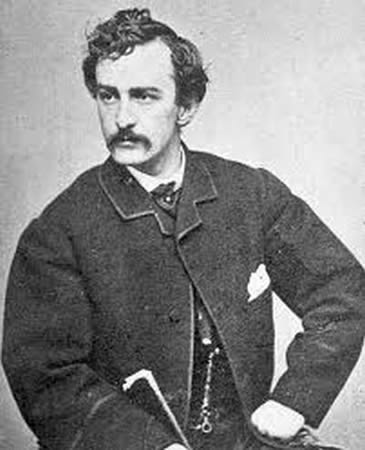
John Wilkes Booth
1865
John Wilkes Booth and his co-conspirator, David Harold spent 12 days on the run traveling through Maryland and Virginia. On April 24th, 10 days after the assassination, Lieutenant Edward P. Doherty, leader of the 16th New York Cavalry Regiment received orders to assemble a detachment of twenty-five men and report to Colonel Lafayette C. Baker, Agent of the Department of War who was accompanied by two detectives for the intelligence service. Luther Baker, cousin of Colonial Baker and Everton J. Conger. Everton Conger had been a Lieutenant Colonel for the Union and had suffered three severe wounds during combat. He had been assigned to detached duty in Washington D.C. joining Colonial Baker’s intelligence service. This intelligence service would later become the Secret Service we know today.
In my research of this pursue, I have read many accounts of what happened. But just recently I have come across an account that not generally seen. This account is from a private that was involved in the pursue of John Wilkes Booth. In reading his account, he has given me a much better view of the timeline that this detachment spent at Belle Grove. The account I am sharing with you comes from the Portland Journal newspaper by reporter Fred Lockley in three separate installments in early February, 1937. This private was Private John W. Millington. Private Millington was born at Chestertown, N.Y., and enlisted in Company E, 93rd New York volunteer infantry, on December 3, 1861, when he was 18 years old.
“On the morning of April 15, 1865, I was on guard, when news came that President Lincoln had been shot at Ford’s theatre.” wrote Millington. “We were ordered to form part of a cordon to prevent the assassin from escaping. Our company was deployed through the brush. It was a chilly day and a cold rain was falling. A few days later we were ordered to Washington, where we served as an escort at Lincoln’s funeral. We were held in Washington, quartered in the J street barracks. On April 24 I returned from a patrol and put my horse into the stable, leaving him saddled, and fed him and went to the barracks to get something to eat. Before I had finished eating, “boots and saddles” was sounded and there was a rush to the stables. We were ordered to fall in as fast as we led out, disregarding company formation. As my horse was already saddled, I slipped on his bridle, led him out of the stable and mounted. I was next on the left of the sergeant. We were ordered to count off in fours. We went to Pennsylvania Avenue and out 14th street about opposite the old Willard hotel. We halted just in front of the office of Colonel Baker, chief of government detectives and scouts. Our lieutenant, Dougherty, reported, and in a few moments he and two detectives, Lieutenants Conger and Barker, came out and mounted, and the order to march was given. We rode to the wharf of the navy yard, on the east branch of the Potomac, or the Anacostia River, where we took the steamer John S. Ide and started down the Potomac.
Lieutenant Dougherty showed us a photograph of Booth and told us he had crossed the Potomac near Port Tobacco.” “We arrived at Acquia Creek and went ashore about 10 o’clock that night. We started scouting through the country, searching all houses and buildings, routing out the inmates and making a thorough search. Next morning early we met some men who had been fishing. They said that a closed hack had passed a few days before, with two men in it. A Confederate captain was in charge, who warned them not to come near. They thought one of the men in the carriage resembled the photograph that we showed them of Booth. We were then on the road to the Rappahannock, toward Port Conway, where we arrived about 2 0’clock. We had not eaten since leaving Washington, so we were told to fall out and rustle some rations. When I returned, with four comrades, we saw some of our company crossing the river in a scow about 20 feet long and 8 feet wide. This ferryboat could hold 10 men with horses, at a trip. In our turn we crossed the river. Mr. Rowlen, owner of the ferry, said he had ferried a carriage a few days previously, and that Captain Jett, formerly of Mosby’s command, was in charge. He believed we would be apt to find him near Bowling Green, about 15 miles from Port Royal, and he volunteered to guide us. Our command was across the river by 4pm and we started. We had traveled about three miles and were approaching the Garrett farm, when we met a man on horseback, who turned and fled. Some of our men pursued, but he escaped in the young pines and as it was nearly dusk he escaped. We arrived at Bowling Green at 11 o’clock that night. We left our horses, with every fourth man counted out to hold the horses. We surrounded the hotel, where we captured Captain Jett. At first he refused to tell us where he had left the two men, but after some forcible persuasion he agreed to show us. He said he didn’t know who they were, except that they were Confederate soldiers who had got into trouble in Maryland and wanted to hide out until the trouble had blown over.”
“The ferryman at the Rappahannock told us that Captain Jett of Mosby’s command had crossed with two men in a closed carriage a few days before. Our company arrived at Bowling Green about 11 o’clock that night. We surrounded the hotel and captured Jett, who, after forcible persuasion, agreed to guide us to where the two men were. He said they were Confederate soldiers hiding out on account of some trouble they had got into. He led us back on the road by which we had come, to within about three miles of Port Royal. He pointed out a house some distance from the road. We opened the gate carefully and, after surrounding the house, knocked at the door. Garrett came to the door. Asked where the two men were, he said “I know nothing about any men being here.” Our officer said to a trooper, “Untie your picket rope. We’ll hang the old man and see if it will refresh his memory.” “A young man ran from the direction of an outbuilding and asked, “What do you men want?” Our officer said, “We want the two men who are stopping here and at once.” He said, “They’re in the barn.” Part of our company was detailed to surround the barn and part to surround the house. I was with the party sent to the barn. Our lieutenant, who heard some whispering in the barn, called, “Come out at once.” One of the men inside the barn asked, “Who are you?” Our officer said, “It doesn’t make any difference who we are, but we know who you are. You had better come out at once.” “The man in the barn who had done the talking was the man we were after – Booth. He refused to come out. He said, “If you will withdraw your men 30 rods, I will come out and we’ll shoot it out.” We could hear Booth accusing the man who was with him, David E. Harold, of being a coward. Harold was willing to surrender and Booth said, “You’re a coward to desert me.” Finally, Booth called out and said, “Harold will surrender, but I will not.” Our captain said, “Tell Harold to pass out his arms and come out.” Booth said, “Harold has no arms. They belong to me.” “Our officer told Harold to come to the door. He came and as he opened the door Lieutenant Dougherty grabbed him and pulled him out. With a picket rope he tied him to a locust tree, called me and told me to guard him. I said to Harold, “Who was in the barn with you? Was it Booth?” He said, “Yes, Booth is in the barn.” and he added, “Booth told me, when he asked me to help him, that he was going to kidnap Lincoln: he didn’t tell me he was going to kill him.” I said, “When you learned that Booth had killed
Lincoln, why did you help him to escape?” Harold said, “Booth threatened to kill me if I didn’t help him get away. Booth came out of the rear of the theatre immediately after shooting Lincoln and we went to Dr. Mudd’s home. After Dr. Mudd had set Booth’s leg we went to Port Tobacco and hid that day. That night we got a fisherman to take us over the river into Virginia. It was so rough that the fisherman said it was unsafe, but Booth told him we had to cross at once and he would kill him if he didn’t take us.” “Once more the officer summoned Booth to surrender. Booth responded, “I’ll fight you single handed, but I’ll never surrender.” Detective Conger went to the opposite side of the barn and lit some loose straw under the sill. I heard a shot and a moment later saw the door was open. Booth had been shot through the neck. They brought him out, carried him to the Garrett house and put him on the porch. A soldier was sent to Port Royal for a doctor, who arrived about daylight. Meanwhile, the barn had burned down and some of the men were hunting in the ruins for relics. They found two revolvers and one of our boys got Booth’s carbine. The revolvers were spoiled by the fire. Booth lived about three hours. He was wrapped in a government blanket, his body was placed in a old wagon and a Negro drove the rig to Acquia Creek, which we reached at dusk.”
“Booth’s body, wrapped in a government blanket, was placed in a wagon, which was driven by a Negro,” Millington wrote. “When Booth was carried from the barn to the porch he was unconscious, but presently came to, and when a doctor who had been called tried to give him some medicine, he shook his head and said it was useless. Booth then added, “Tell my mother that what I did I did for the good of the country.” “The two Garrett boys had returned home shortly before we got there. They had been with Mosby’s command. One of them had a young wife and there was a tearful scene when our officer told the boys they would have to go to Washington with us. Captain Jett was allowed to escape. I understood at the time that if he guided us to Booth and Harold he would not be held.” “When we arrived at Acquia Creek we went aboard a vessel. I was ordered to stay in the cabin and guard Harold. Another trooper was stationed outside the door. Harold was soon sound asleep on the floor. When I was relieved, I was cold, as I had no overcoat, so I went below and lay down near the boiler and slept until we arrived near one of the monitors at Washington. After we were made fast, the lieutenant ordered me to help carry Booth’s body aboard the monitor. We laid his body on the deck. I was tired and hungry and much more interested in getting to barracks for a good meal and a good sleep than knowing what was to become of Harold and Booth’s body. I stabled my horse and went at once to my bunk. When I awoke, about 10 o’clock, the papers had long articles about the killing of Booth and the capture of Harold.”
In the account, Private Millington wrote “We were then on the road to the Rappahannock, toward Port Conway, where we arrived about 2 0’clock. We had not eaten since leaving Washington, so we were told to fall out and rustle some rations.” This statement confirms the information I had undercovered that the detachment had made a stop at Belle Grove. In my information, the detachment had split up in King George to form two search parties. At was Port Conway and Belle Grove that they met back up. My information stated that half of the detachment had gone to another plantation (most likely Walsingham Plantation) and the other half had come to Belle Grove. Everton Conger was with the detach at Belle Grove. Due to his severe wounds that he had received during the Civil War, traveling on horseback had taken a toll on Lt. Col. Conger. It was here that he slept in the main hallway.

Lt. Col. Everton Conger
It wasn’t until this account that I knew for sure the amount of time they spent here. From the account, it looks as if they were in Port Conway for about 2 hours. More than likely Everton Conger was one of the last that left Port Conway allowing him time to rest.
The ferry that Private Millington spoke about is the ferry located at Port Conway. We are doing research on the ferry owner, Rowlen. I am not sure if that is the correct spelling or not yet.
In 1892, a lawsuit was brought before the court between Rose Hunter (Susan Rose Turner Hunter) and her son Thomas Lomax Hunter. The suit was brought because Rose was the sole owner of Belle Grove Plantation. Of the four daughters that inherited the property, Rose was the only one left. Caroline Turner Jett had passed in 1883. Anna Turner Robb has passed in 1880, and Alice Turner Matthew has passed in 1875. Rose was no longer living at Belle Grove, but had leased it to Samuel Andrew McGinnis and an African-American Family. It is my understanding that Rose had divided the Mansion and was using it as a duplex. The McGinnis Family lived on one end and the other family on the other end. The reason Thomas had sued his mother was because the mansion had fallen into disrepair. Rose was not going to the plantation to check on or maintain the property. It was the order of the court that a trustee, John Mason, be assigned to handle the property and its sell.
On July 5, 1893, John E. Mason, acting as a trustee sold “Belle Grove Farm” to John Tayloe Thornton of Port Royal for $9,900.00 with part being paid in cash and the other being secured after the deed was executed. (1894 Picture)
The rest of John Thornton’s history is pulled together through newspaper articles.
My first article comes from the Alexandria Gazette dated July 3, 1893. It talks about a gentleman from Fredericksburg who relates that John Tayloe Thornton of Port Royal has purchased Belle Grove. It states that he is a wealthy bachelor. This seems to be correct. I have found information that his father, Champe B. Thornton was a wealthy merchant from Port Royal. I also found that John owned several lots in the town of Port Royal too. It goes on to say that John Thornton has paid $9,000 for Belle Grove which was $20 an acre. This means that he purchased 450 acres. Now this is the first time I have seen the acres change from the 700 that was sold to John Hipkins. I am not sure who had the other 250 acres. I did find out that the Robb Family, Anna Turner Robb and her family had a home on the back section of the 700 acres. It could have been that she received it from her father and mother at the time of her father’s death.
But here is the best part of this article. It seems that John Thornton purchased Belle Grove in order to convince a young lady to marry him. It says in the article that this young lady told him that he had to purchase Belle Grove or she wouldn’t marry him. So he purchased Belle Grove. Question is, did she marry him?
A second article appears in the Times from Richmond dated July 6, 1893 confirming that John Thornton purchased Belle Grove Plantation. It doesn’t mention the young lady, but it does mention that this plantation is where President James Madison was born.
Now you may remember this photograph from 1894. I found it early on in my research. But for several months I was under the assumption that the person on the front porch was an African-American in a white dress. I assumed it could have been a former slave of the plantation. It wasn’t until just last month, while we were viewing the original glass plate photo that I realized that it wasn’t an African-American woman, but a man in a white suit sitting down next to a young boy in a dark suit! Looking at the dates of the photo, this could only be one person, John Tayloe Thornton! I am not sure who the young boy is. At the time of the photo, he was not married and didn’t have a younger brother. Could it be a nephew or even a child of the young lady he is wanting to marry? Either way, you have to note the wonderful bow tie he is wearing as well as the fact that his hair is parted in the middle and slicked down. And if you look close, the young boy looks to have knickers on! Very handsome indeed!
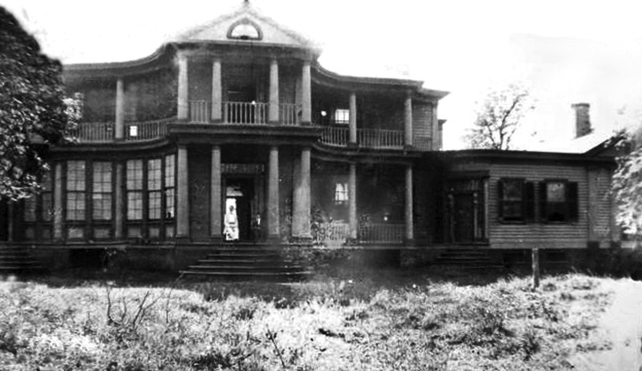
Belle Grove Plantation – First Known Photograph 1894
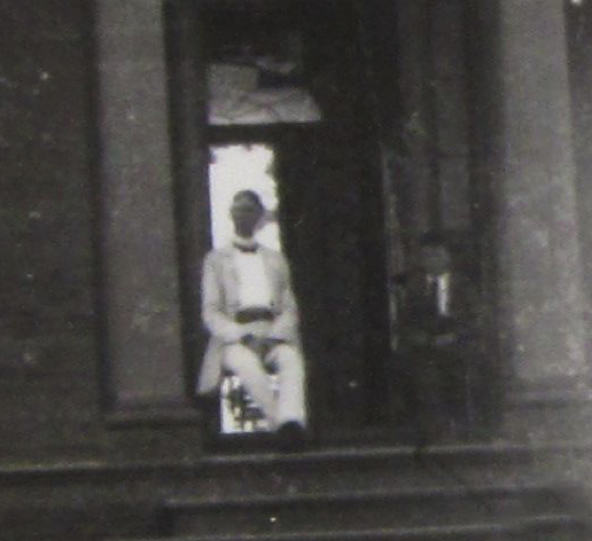
Meet John Tayloe Thornton
July 19, 1894
Our next article comes from the Alexandria Gazette dated July 28, 1897. Seems that the young lady decided not to marry dear John Thornton. So now he is stuck with this huge plantation. So it looks as if he is selling Belle Grove. But what a surprise to find out who John is selling it to and what they plan to do with Belle Grove. In the article, it states that another Washington paper has claimed that Belle Grove has been sold for $15,000 for 500 arces of land. Belle Grove is to become an Industrial College and Farm for Colored Students.
It states that Belle Grove has six dwellings on the property, one with twenty rooms. I would assume that would be the mansion. There seemed to have been a convention of some sort in Colonial Beach, which is just 20 minutes from Belle Grove. At this convention, $7,000 was raised of the $15,000. It also states that one of the people working on the project is a “colored man” that owns President James Monroe’s birthplace. This is located just outside of Colonial Beach. It names the new President for this Industrial College as H.A.J. Cyrus of Port Royal. It also mentions J.M. Langston who either lives or works in Washington D.C. I am assuming that he might be a representative or senator.
Just a couple months later the Alexandria Gazette dated September 16, 1897 states again the John Thornton has sold Belle Grove to Charles W. Hillers of West Pittston, PA for $15,000. But here is another article from the Alexandria Gazette dated March 26, 1889 that states Charles W. Hillers Of Pittston, PA has purchased Belle Grove from John Thornton for $13,000! Somewhere along the line, $2,00o got knocked off. Could this be a sign that this group purchasing Belle Grove is having issues raising the remain balance?
Well here is our answer! This article from the Alexandria Gazette dated April 1, 1899, over a year later, states that a lawsuit has been ongoing over the sale of Belle Grove. It seems that a judgement in the case between John Thornton and Charles Hillers (Hellers) has been passed down. In the case John Thornton states that the terms of the sale had not been met. The judgement awarded Belle Grove back to John Thornton.
So after the lawsuit and John Thornton receiving Belle Grove back, the history goes a little dark on Belle Grove. Two years would pass before we again hear that John Thornton has moved into Belle Grove with his family! I have not been able to find a date of marriage for John and his bride, Louise Disney Thornton. I don’t think she was the young lady that he purchased Belle Grove for to start with. I think she came along during the two years of no history on Belle Grove.
This article and a second from the Times in Richmond dated May 15th and May 23rd of 1901 also gives us a little detail of the mansion at Belle Grove. It talks about how splendid the house is. It states that it has marble mantels, large porches and beautifully carved brown stone steps. The article talks of it costing $20,000. I am not sure if they are thinking the steps cost $20,000 or the whole property. This is a little confusing because the steps were there when he purchased Belle Grove in 1893. You can see them in the 1894 photo. And I don’t think that John Thornton had to purchase Belle Grove again since he had already won it back in 1899. So that part is a little unclear. Unless John sold it after the lawsuit and had to purchase it back. I don’t have any information on that, but you never know.
The second article also talks about the fact that John Wilkes Booth died just two mile away from Belle Grove.
I don’t have an article on this, but I do know that John and Louise’s first child, Elizabeth Grammer Thornton was born in August 14, 1901. She was named after his mother. Grammer was his mother’s maiden name. Just three months later we would see our next article from the Free Lance Star in Fredericksburg dated December 03, 1901. It tells about an event on November 28, 1901 at Belle Grove. Elizabeth Grammer Thornton was christened. This is the first time we have found a christening at Belle Grove. It states that Rev. Turner performed the ceremony. Could this be one of the relatives of Carolinus and Susan Turner? Most likely yes. I just don’t know which one.
The ceremony was witness by a large group of friends from Port Royal and King George. It states the house was decorated with holly and chrysanthemums. It also states that refreshments were served.
Now you know that John was a wealthy man when you find an article stating that he and his family just went to Fredericksburg! This article is from the Free Lance Star of Fredericksburg dated January 23, 1902. Could they have been there to show off their new daughter? Or maybe a little shopping.
The next article from the Free Lance Star of Fredericksburg dated June 7, 1902 gaves us a look at the farm and some of what they had on the farm. Here they are looking to sell ten good Milch Cows. Okay, I am not a person who knew what a “Milch Cow” was, so I had to look it up. A Milch Cow is a cow that is kept for milking. A dairy cow. The image I got was that of a cow you see in the Chick-fil-a commericals. These ten cows are said to be gentle and kind. They are also looking to sell five good horses from three to nine years old.
They are also looking to purchase thirty steers and heifers. Could they been thinking of starting a dairy farm?
There is no article for this next event for the Thorntons. On April 12, 1903, John Tayloe Thornton Jr. was born to John Tayloe Thornton and his wife Louise. But this joy wouldn’t last very long. Just two months later they would lose baby John on June 23, 1903.
After the sad loss of baby John, we don’t hear again from Belle Grove until an article from The Free Lance Star of Fredericksburg dated May 10, 1904 appeared. This article talks of visitors to Belle Grove. Two visitors from Fredericksburg, Mrs. Frances Tabb Newman and her niece Miss Parker Herndon had been visiting with the Thorntons at Belle Grove and had just returned home.
It talked of a tea party that the Thornton’s gave at Belle Grove for several of their friends. They served refreshments in the “handsome and spacious” parlors. How cool to know that we will be following tradition with serving tea and conducting tea parties at Belle Grove too! After the tea party, it states that the young people played a game of tennis! Do I see a grass tennis court coming to Belle Grove in the future? Could be!
After years of use, every home needs a little improving. In the next article from the Free Lance Star of Fredericksburg June 23, 1904 talks of improvements that were done at Belle Grove. It tells about painters, slaters and tinners working on this beautiful home. It is the first time we see that the mansion is painted a cream yellow with white trim and green blinds. Surprising this is the current color of the mansion! During the restoration from 1997 to 2003, the mansion had been taken from the green exterior walls back to this color combination. Could it be this history that they were bring back to the mansion?
Also in this article we get another look at the farm and its working. It talks about ten men working the wheat fields cutting wheat. He is also selling corn at 65 cents from the barn.
At the end of this article we get a view of Port Conway that we have never seen. We have known of the Ferry House and the Post Office from pictures. We have also known that Port Conway had twenty lots with one being a church. But this is the first time we have found out that Port Conway had a hotel! Hotel Harriman is spoken of and is said to be doing well. They are expecting to built a new hotel soon. And what is this? Port Conway had long distance phone! And a daily steamboat. This steamboat seems to be bringing outside visitors to the area who are looking to move into some of the farms. What’s this? Two of these outsiders came to see Belle Grove! Oh no! Are we looking to see Belle Grove again? I am with this writer who states “If I owned Belle Grove, I would never sell it”.
In what I would called a “gossip column” of the Free Lance Star of Fredericksburg dated August 13, 1904 we see Arthur Thornton and his family visiting Belle Grove. Arthur is John Thornton’s youngest brother.
This next article has to have one the prettiest headlines. But sadly the news isn’t as nice. This piece from the Free Lance Star of Fredericksburg dated September 29, 1904 tells us that a “colored man” named John Smith broke into Belle Grove and stole a gold watch. For his crime, John Smith will spend six months in jail. This is the first crime we have confirmed at the plantation.
You know you are big time when your Christmas celebration makes not just one, but two papers! The first article is from The Daily Star dated January 1, 1906. It talks about how the Thorntons and little Elizabeth received a visit from Santa Claus at Belle Grove with several friends. What a wonderful insight of little Elizabeth answering the door bell (the first time we have heard of a door bell at Belle Grove) and greeting Santa. It tells us that she ushered him into the dining room where he greets other guests and children. From there they went to the parlor where a large tree was decorated with lights (most likely candles!) and gifts were presented to each of the younger children along with a cornucopia of candy. The older children enjoyed refreshments.
Later the children would play a game of “Snapping Dragon”. Now here is what I found out about this game. According to Wikipedi:
“Snap-dragon was a parlor game popular from about the 16th to 19th centuries. It was played during the winter, particularly on Christmas Eve. Brandy was heated and placed in a wide shallow bowl; raisins were placed in the brandy which was then set alight. Typically, lights were extinguished or dimmed to increase the eerie effect of the blue flames playing across the liquor. The aim of the game was to pluck the raisins out of the burning brandy and eat them, at the risk of being burnt. Samuel Johnson’s Dictionary of the English Language(1755) describes it as “a play in which they catch raisins out of burning brandy and, extinguishing them by closing the mouth, eat them”.
According to Robert Chambers’ Book of Days (1879) the game was accompanied by a chant:
Here he comes with flaming bowl,
Don’t he mean to take his toll,
Snip! Snap! Dragon!
Take care you don’t take too much,
Be not greedy in your clutch,
Snip! Snap! Dragon!
With his blue and lapping tongue
Many of you will be stung,
Snip! Snap! Dragon!
For he snaps at all that comes
Snatching at his feast of plums,
Snip! Snap! Dragon!
But Old Christmas makes him come,
Though he looks so fee! fa! fum!
Snip! Snap! Dragon!
Don’t ‘ee fear him but be bold —
Out he goes his flames are cold,
Snip! Snap! Dragon!”
The house is also decorated in holly and cedar. I bet that smelled wonderful! Now we have an idea of how to decorate for next Christmas! Anyone up for a game of “Snapping Dragon”?
There isn’t an article for this event. On August 6, 1906, Louise Beatrice Thornton was born at Belle Grove. She would be the last of the Thornton Family to be born at Belle Grove.
In an article from the Free Lance Star of Fredericksburg dated October 4, 1906, we learn that the Thornton Family’s time at Belle Grove has come to an end. John Thornton would sell Belle Grove to Mr. J.F. Jack of Los Angeles, California. Mr. Jack already owns Walsingham, the plantation just next door. In the time of the Turners, Walsingham was owned by George Turner while Carolinus Turner owned Belle Grove. George was Carolinus’s cousin. By combining the two plantation, there would be 1,400 acres of farm land.
Mr. Jack will not take Belle Grove until January, 1907. He would live at Belle Grove in the mansion. Walsingham had lost it’s beautiful home years before.
In the second article from The Times-Dispatch of Richmond dated October 4, 1906 we find out that Mr. Jack purchased Belle Grove for $22,000. Not a bad profit for John Thornton of $13,000.
John Thornton would own Belle Grove for just thirteen years. In that time he would get married, have three children, lose one as an infant and set himself up as a prominent member of the community. He would improve the mansion giving us the warm cream yellow walls with white trim and green shutters. He would also give us the oldest known photo of Belle Grove and the first photo of an owner as well.
Best of all, through the newspapers of the time, we have had an opportunity to view a little of what life was like for a family at Belle Grove.
In an article from the Free Lance Star of Fredericksburg dated October 4, 1906, the Thornton Family’s time at Belle Grove has come to an end. John Thornton would sell Belle Grove to Captain John Fremont Jack of Los Angeles, California. Captain Jack already owns Walsingham, the plantation just next door. In the time of the Turners, Walsingham was owned by George Turner while Carolinus Turner owned Belle Grove. George was Carolinus’s cousin. By combining the two plantations, there would be 1,400 acres of farm land.
Captain Jack will not take Belle Grove until January, 1907. He would live at Belle Grove in the mansion. Walsingham had lost its beautiful home years before.
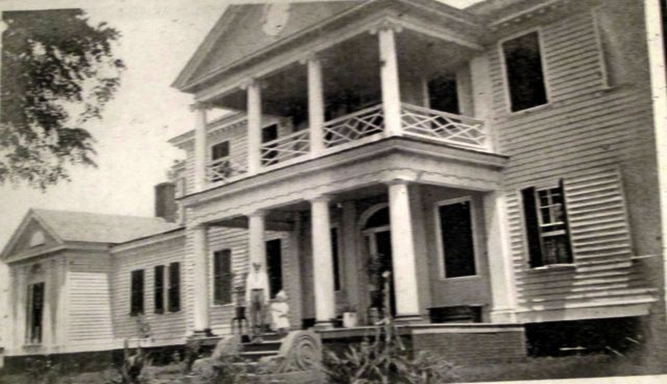
Belle Grove Plantation 1906
Possibly John Fremont Jack
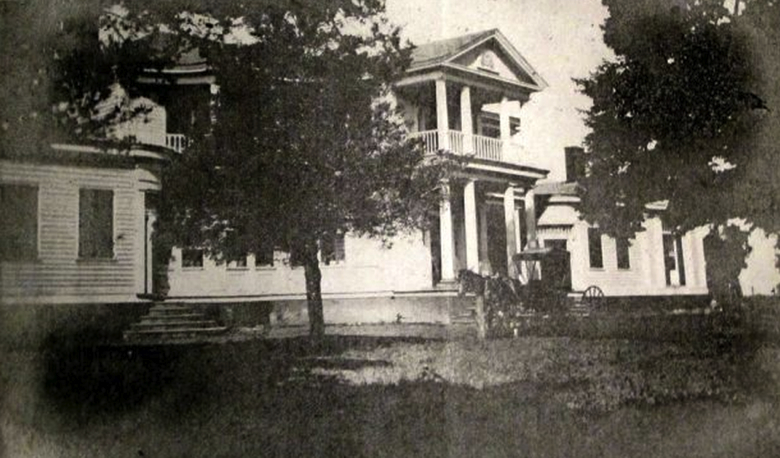
Belle Grove Plantation 1906
In the second article from The Times-Dispatch of Richmond dated October 4, 1906 we find out that Captain Jack purchased Belle Grove for $22,000. Not a bad profit for John Thornton of $13,000.
But who was this Californian that purchased these two beautiful plantations? This has been a question for us for a long time. In all the research I have done on the plantation, this is one of the owners whose past has been hard to uncover. Believe it or not, I found more on the Colonial Period of this plantation than I have with the owners of the early 1900s.
From what I have uncovered, Captain Jack was an experimental farmer from California. He arrived in Virginia in the early 1900s with the goal to find out if alfalfa would grow in Virginia. As far as the personal side of Captain Jack, the only information I have is that he was born in Ohio and married to Belle Warner Jack. Once again I had to turn to newspapers to build something of a history of him.
The first time we found Captain Jack in the newspaper was in February 1907. He would have owned Belle Grove for about four months at this point. In this article, it reports that Captain Jack has shipped a “carload of very handsome young mules”. It even gives us how many are in a “carload”. There were 24 total and they came from Kentucky.
The next article gives us more insight into why Captain Jack moved to Virginia. We know he was an experimental farmer, but from reading this article, it seems that he was also here to teach. In the summer months of 1909, The Farmers Institute put on a cruise down the Rappahannock River with the goal to give local farmers the opportunity to hear about new and more modern methods of farming. This cruise which started in Fredericksburg was headed by “Commodore” George Wellington Koiner, Commissioner of Agriculture and Immigration and several instructors. Touring on the good ship “Gratitude” they would touch eight counties and their farmers along the Rappahannock River.
One of the speakers was Captain Jack of Belle Grove. They speak of how Captain Jack of Port Conway was a successful alfalfa hay-maker. He was to “explain to the farmers how he came to sell out his possessions in California to come to Virginia soil to make alfalfa and what wonderful success has followed his efforts.” Known locally as “Alfalfa Jack”, he would tell how he came to Virginia in 1906 and spent several months traveling the area and observing “the general conditions with the respect to alfalfa growing.” He had observed that alfalfa could be grown in small quantities, but what he wanted to know is if it could be produced for commercial purposes and in large enough quantities to make it profitable.
Once he had determined that the area was sufficient to justify the venture, he set forth to find the right place to do it. The land he was looking for “must be slightly undulating, but not rough or steep, that would not wash, that was not too sandy or too loose, too stiff or cold and clammy, not too stony, not too spongy, that was not too wet or too dry, that was well drained, not so badly “worn” as to be unresponsive to treatment, that was on good water transportation, within easy access of some of the great markets of the East and where lime could be obtained at a cost that would admit of its use in liberal quantities’.” Whew… He wasn’t too picky was he?
He would find this land in the two plantation estates of Belle Grove and Walsingham. He states that the soils of these plantations were greatly depleted, but he felt that they had a character that would respond quickly to treatment. With the aid of crimson clover and cowpeas and a liberal application of fertilizer and lime, he felt that he could create alfalfa fields that would compare to the best in the East or West.
After two years, however, he found that the soil was more depleted that thought and it was taking a lot longer to ready the soil. At this point Captain Jack had only 300 acres of alfalfa, but was expecting to plant 200 acres more next fall. Plus he had several hundred more filled with crimson clover and cowpeas ready to be plowed under for future fields. Captain Jack felt that with crimson clover and cowpeas as aids, if used throughout Virginia, the state would soon stand “in the front ranks for fertility and production.”
It states that Captain Jack was still working on adding to his acreage and that by one year he was expected to have over 1,000 acres. He stated that the coming year of 1908, he was expecting to yield just under 4 tons an acre and without advertising or marketing and through shipment by steamer from the Port Conway wharf, he felt that the price would be better than most. He also saw that in the coming years the demand and price would increase as the product became better known in the East.
He explained though that before undertaking this crop, one had to know the plant and everything that it needed. He states that alfalfa has a “mind of its own” and it knows what it wants and needs. And if a farmer took on this crop without the right knowledge, he would lose his investment.
Captain Jack summoned up his thoughts:
“For him who understands its language and unsparingly supplied it needs, it will clothe his fields in beauty, supply his herds with food, enrich his soil, multiply the value of his land and lay its richest treasure at his feet in grateful acknowledgment of his toll and care. I believe that before many years Old Virginia will have many income producing alfalfa farms. It is a result well worth striving for. It is the crop which more than all others will redeem the lands of the Southern and Eastern States – lands which in so many ways have been so wonderfully favored.”
In 1909, we find our next piece which is more of a social note in the newspaper. It doesn’t talk about Captain Jack, but it speaks of Mrs. C. Shirley Carter who is a guest at Belle Grove. She is visiting her son, C. Shirley Carter. I haven’t had a chance to research this name, but it is strange to me to see both mother and son with the same name.
Almost three years has now gone by since the article about how Captain Jack was building his alfalfa fields. By 1910, we see from this article that Belle Grove has become a noted success in alfalfa.
In the summer of 1910, another social note in the newspaper talks about a visit from Miss Minnie King of Richmond. She is to be a guest of Miss Lille Taylor of Belle Grove. While this is another name I haven’t done research on yet, we can assume that they are farm hand workers and their families on the plantation.
Also in the summer months, not only were farm hands and their families getting visitors, by is seems Captain Jack received a guest too. A local Stafford farmer traveled to Belle Grove and Walsingham to see Captain Jack and his successful alfalfa fields. There had already been a 400 ton cutting that was waiting to be shipped. And in only ten days another 400 tons was to be cut. Captain Jack amazed his visitors with his success and his modern farming methods.
Another article in the summer of 1910, just three years after the “Farmers College” tour down the Rappahannock, the first report of the success of that “teaching cruise” had started coming in. It talks about the apparent success of farmers all the way from Fredericksburg to the Chesapeake Bay giving evidence of this success from the appearance of houses, barns, fences and fields along the river.
In Port Conway, after proving his modern method, Captain Jack has also started showing signs of success. He has built a new wharf for shipping his alfalfa and a new more roomy warehouse. He has also installed an ornamental lake on the property.
It seems that the summer of 1910 was attracting many to Belle Grove and Walsingham to marvel at the success of Captain Jack. Another visitor, Professor Carrier visited the plantations in August. There he found that Captain Jack had already two cuttings of alfalfa that season and was already cutting a third. He also explained that Captain Jack was expecting to get two more cuttings before the season was out.
In his inspection of the plantations, Professor Carrier reported that the word of the success of the crop had not been exaggerated. He praised Captain Jack’s method of farming and expected if others in the State followed suit, they too would meet with the same success.
In October, 1910, another social note from Belle Grove. Miss Annie Gwathmey paid a visit to her cousin, Miss Lille Overton Taylor at Belle Grove. I have noticed that the social notes of what I think are farm hands and their families seem to appear in smaller columns, while visitors of Captain Jack are writing in stand-alone articles.
Here we see that Captain Jack has received visitors in November, 1910. This large party of seven from California paid a visit to Fredericksburg to see the sites. I wonder what locations they would have seen. Was Kenmore Plantation open at that time for visitors? Or did they stop at the Rising Sun Tavern, owned by Charles Washington, brother of George. Or did they visit the battlefields that lay around Fredericksburg to see where past family and friend fought the Civil War?
In February, 1911, Miss Lilly Tayloe of Belle Grove had family from Richmond visit. Again, it is in a smaller column so I am assuming a wife of a farm hand. We will have to see with some more research.
The last newspaper article I found on Captain Jack was that of a fire in the barn at Belle Grove. The barn and 250 tons of alfalfa were lost along with a large amount of farming equipment. The origin of the fire was never known. It resulted in a $10,000 loss. Captain Jack did not have insurance on the barn or equipment.
From here the trail grows cold. I have not been able to find any other information on Captain Jack. We know that he sold the plantations December 13, 1916 to two more Californians. But from here, the trail of Captain Jack goes cold.
By the time Captain Jack had sold Belle Grove Plantation, Captain Jack had acquired both Belle Grove and Walsingham Plantations. This brought his holdings to 1,462 acres of farm land that he proceeded to develop into an alfalfa farm.
On December 13, 1916, Captain Jack sold his holdings, both Belle Grove and Walsingham Plantations to the South and West Improvement Company. This company was owned equally by William H. Allen Jr. and Otto F. Brant of Los Angeles, California. The purchase price was$150,000.
On September 12, 1917, Otto F. Brant and his wife Sue E. Brant and William H. Allen Jr. and his wife Elsie Allen donated to Allen Smith, William T. Smith, J.A. Lewis, B.T. Tayloe, and W.A. Rose , trustees of Emmanuel Church a small portion of Belle Grove Plantation which was already enclosed by a fence.
The farms were successful and would earn 5% on its cost, when Otto F. Brant decided to make a job for his nephew, Brant Elliott, by putting him in charge. Unfortunately, Elliott was not a good manager and soon had the farms in debt. William Allen Jr. decided upon a division of the property and received Belle Grove Plantation, 100 acres of Walsingham and Port Conway.
This division happened on June 30, 1923. Brant F. Elliott and his wife, Jouett Fall Elliott of Three Rivers, New Mexico divided the two estates with William H. Allen Jr. The purchase price for William H. Allen Jr.’s portion was just $10.
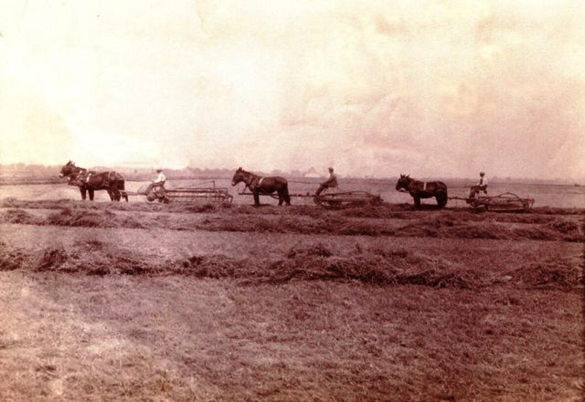
Belle Grove Plantation – 1920s
There isn’t much more about William H. Allen Jr. until he sold Belle Grove Plantation in 1930 to the John Palmer Hooker and his wife Mary.
On April 7, 1930, William H. Allen Jr and his wife Elsie Allen of Los Angeles, California sold Belle Grove Plantation to John Palmer Hooker of Chicago, Illinois. John Hooker purchase Belle Grove Plantation for $45,000.00. At that time, the village of Port Conway was still there. There was a lane that ran down the center of the village, but most of the village was owned by William H. Allen and was sold to John Hooker.
John Palmer Hooker was born in Watertown, New York, was a real estate investor from Chicago, Illinois. He was the 9th generation from Rev. Thomas Hooker, son or grandson of Rev. Richard Hooker, Archbishop of Canterbury to Henry VIII.
His wife, Mary Ensley Hooker was from Memphis, Tennessee. Mary Beecher Ensley was born in 1892 and was the daughter of Colonel Enoch Ensley and Mary Leavenworth Beecher. She married Lendrum DeWest Murrell in 1915 and they had two children, DeWest Murrell (1918-1999) and Enoch Murrell (1919-2011). Lendrum Murrell passed away in 1919 and Mary remarried John Palmer Hooker in 1926.
John Hooker adopted DeWest and Enoch. He and Mary had three children together. Two passed away as infants and their only daughter, Mary Hooker Huth (1930-1972).
From the oral history, John and Mary purchased Belle Grove Plantation as a summer home. Mary had grown up on a southern plantation in Tennessee so for her, Belle Grove was to be her southern plantation. She worked tirelessly to create the perfect plantation. We had the chance to talk to her grandson on Enoch’s side and he told us how Mary was so particular about how her home looked. She would set her décor in just a way. Of course her grandson also told us how he would go around and move things just to get under her skin.
During the Spring, Mary and John would hold garden tours of the house. They had created an Old English Boxwood Garden on the riverside of the mansion with a large white fountain as the focus point. Mary would also have Lemonade Social on the bluff during the lazy summer days.
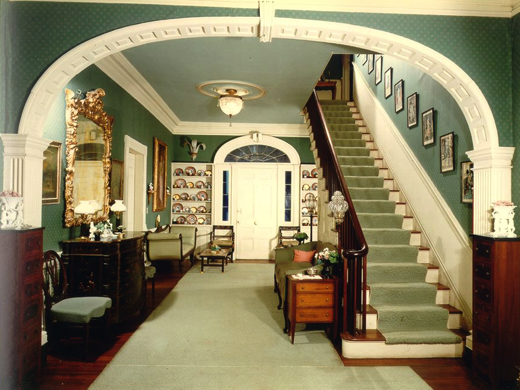
Belle Grove Plantation – Hooker Period
Grand Hallway – Downstairs
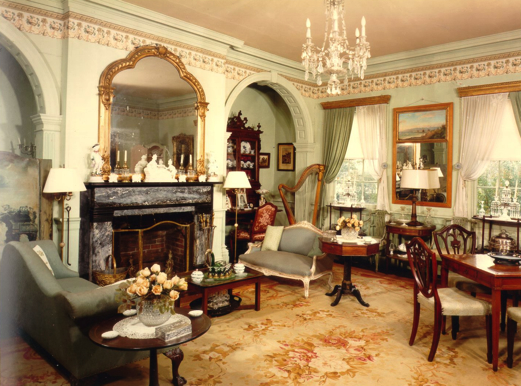
Belle Grove Plantation – Hooker Period
Parlor – Now Formal Dining Room

Belle Grove Plantation – Hooker Period
View on the Riverside Portico towards the River and Fountain
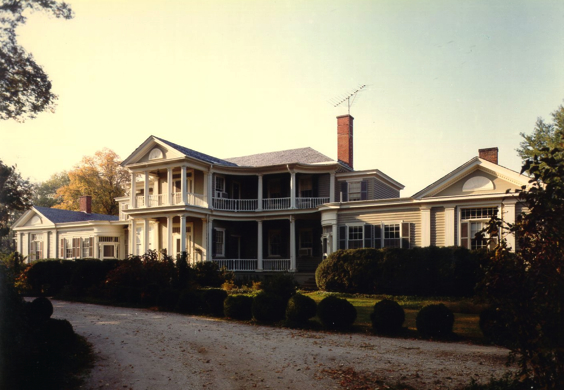
Belle Grove Plantation – Hooker Period
Plantation Side
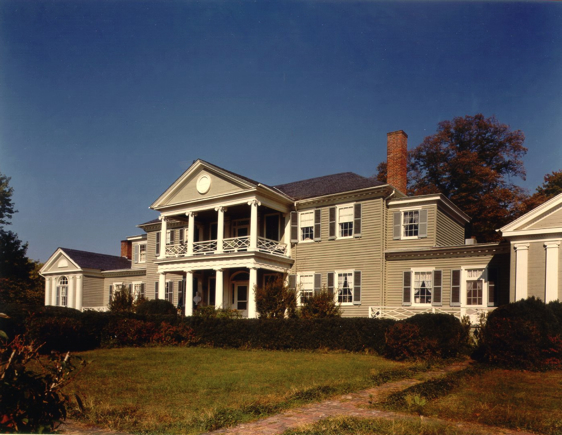
Belle Grove Plantation – Hooker Period
Riverside
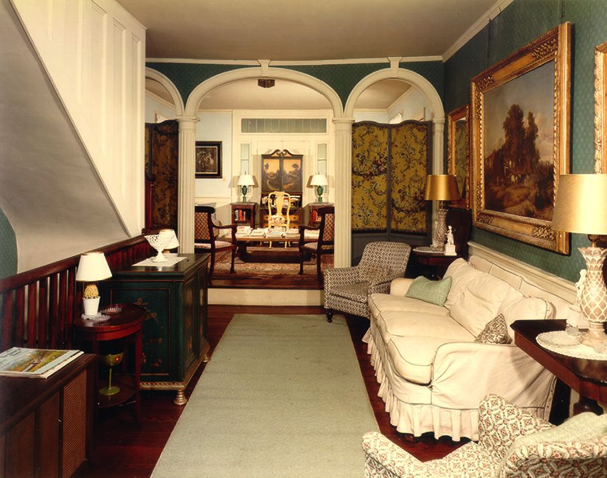
Belle Grove Plantation – Hooker Period
Grand Hallway – Upstairs
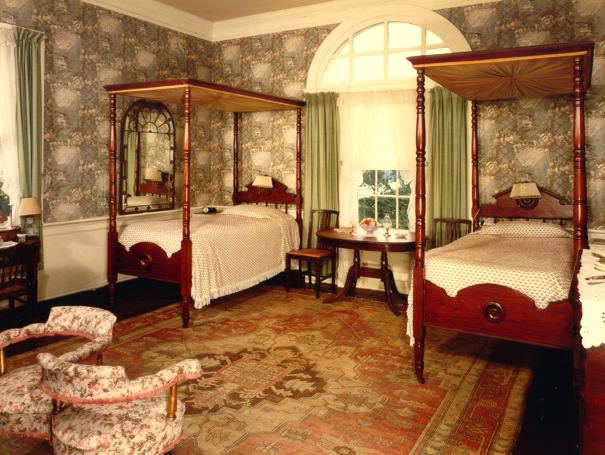
Belle Grove Plantation – Hooker Period
Now the Kitchen
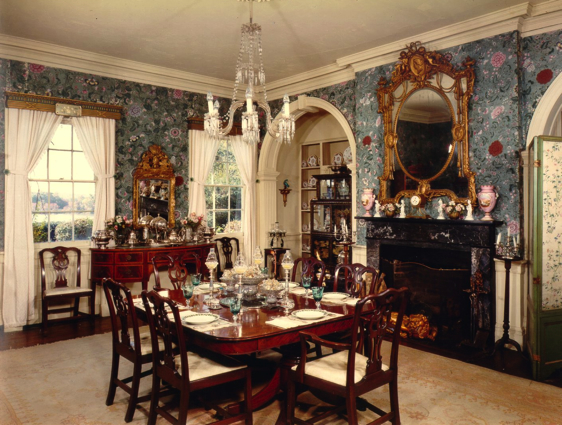
Belle Grove Plantation – Hooker Period
Formal Dining Room – Now the Parlor
John was also very particular about the grounds. He went so far as to buy the property just across the water so no one would build anything and mess up his view.
During their time at Belle Grove, John and Mary held a picnic in conjunction with the building of the first James Madison Memorial Bridge. This bridge was built in 1934. The picnic was attended by 4,000 people. To build the bridge, John Hooker had to sell 2.06 acres of Belle Grove to make way for the bridge. He sold to the James Madison Memorial Bridge, Inc. for $1.00.
Just after John P. Hooker’s death in 1974, an article was written in the Free Lance Star in 1976 about Belle Grove and Mary Hooker.
“Time didn’t fade splendor of Belle Grove”
By Cyndi Young
When the John Palmer Hookers were married, he had the notion they would eventually retire in southern California. “I threw up my hands in horror and screamed, ‘No, no, no, no, no!’ “ Mrs. Hooker recalls with a laugh her reaction nearly 60 years ago.
She’d been to California, she said, and “all I could remember was old folks walking around with nothing to do.”
So in 1930, 12 years after their wedding and a year after the Great Panic on Wall Street, the Hookers found their way to King George County, Virginia, and soon purchased Belle Grove plantation.
Since Hooker’s death in 1974, his wife and son, Ensley, live alone in the great estate house. The trimming could use a coat of paint and the silver a little polishing but Belle Grove still retains the quiet dignity it has enjoyed since it was built in 1718.” (wrong date reported)
Belle Grove-at least the property there – has seen its share of history.
The original manor house, long since rebuilt after it was demolished by fire, was owned by the Francis Conway family.
Daughter Nellie Conway, soon after her marriage, returned there in 1751 to bear a son – James Madison, who was destined to become the fourth president.
The region around the Conway tract on the Rappahannock River was named Port Conway for the wealthy, illustrious family.
After the Conways disposed of the land, it had a long succession of owners, whose names Mrs. Hooker refuses to remember. “My husband kept up with all that,” she said.
Her husband, she recalled with a smile, was reputed to know more about real estate than anyone else in Chicago.
He loved Chicago, she said, and stayed there, a successful businessman, until his retirement.
Mrs. Hooker – maiden name Mary Ensley – was the daughter of a prominent iron ore producer who built the town of Ensley, Alabama, as a model town for his employees.
When he died, her mother, low on money while the estate was being settled, became society editor of a Memphis newspaper and arranged for her daughter to travel extensively in Europe.
When she was 15, Mrs. Hooker claimed she was a year older in order to center Vassar College. Her roommate was Carolyn Hooker.
Often, the girls and their school friends would catch the train for Chicago, armed with their Marshall Fields credit cards, and spend the day shopping, chaperoned by Carolyn’s brothers.
“I was his younger brother’s girl,” Mrs, Hooker recalls. But Hooker soon decided “that he had to have me.” His persuasion worked and the pair were married in 1918.
When retirement time came, they decided to buy Belle Grove, which had fallen into disrepair. The five-unit Georgian house, built with a commanding view of the Rappahannock River, boasted a two-story front portico, curved doorways, spacious rooms, arched windows, balconies but only one bathroom.
The Hookers were still living full time in Chicago, so for years, Mrs. Hooker camped out in King George each spring, cleaning, painting, planning and repairing the aged house, bit by bit.
There was no bridge in those days connecting the Port Royal side of the Rappahannock to the Port Conway side, she went on, so each spring day she rode a tiny ferry from a friend’s house to Belle Grove.
“I was always quite a collector,” she says, describing how she procured the furnishings, china, paintings and kinck-knacks which comprise the eclectic décor of Belle Grove.
An antique buff and a lecturer on English silver, Mrs. Hooker haunted antique sales and kept an eye out for bargains through the years.
Her first major project with the house was to have six bathrooms installed.
The house has six bedrooms – two in each wing and two upstairs. Upstairs, the bedrooms have windows on both east and west, and “you can see the sun come up in the morning and go down in the evening.” She says.
As the children grew up and left home, Mrs. Hooker transformed their playroom into a breakfast nook and moved the downstairs kitchen up into the butler’s pantry across the hall from it. She also had a balcony built out from the breakfast room so that they could eat breakfast there on nice mornings.
The house is filled with unique furnishings, most of which were brought by Mrs. Hooker on her travels.
The living room contains an “Act of Parliament clock” which antedates the familiar grandfather and grandmother clocks, she said. The design resembles the grandfather clock, but the entire mechanism is suspend from the wall.
The bedrooms are filled with antique canopied beds, one of which came from a Welsh castle.
The living room floor is covered with an early Louis XV tapestry. The dining room walls have hand-painted canvas wallpaper.
Mrs. Hooker’s gargantuan silver collection includes a unique two-sided cream pitcher – used by the Hookers because he was left-handed and she is right-handed.
The manor house is flanked by a swimming pool, an old spring house converted to hold the pool pump and an old outside kitchen, which has been redecorated as a guest house.
All told, the house is surrounded by more than 600 acres, including a 45-acre parcel across the river which Hooker bought to protect the view from his back balconies.
Belle Grove exterior is painted a demure soft gray-green.
“When we bought the place, all colonial-style houses were painted white with green shutters,” she noted. “I wanted to paint it this soft green color.
“My husband was really worried that I was going to make a terrible mistake so I drove him to Williamsburg and showed him that all colonial houses do not have to be white and green,” she chuckled.”
John Palmer Hooker would pass away on July 5, 1974. After John passed away, Mary would use Belle Grove Plantation as a boarding house until her death on September 25, 1981. DeWest Hooker would move away and Enoch Hooker stayed until he sold the plantation in 1987.
On August 28, 1987, the Haas Corporation from Austria purchased Belle Grove Plantation from Enoch Hooker and DeWest Hooker.
In 1997, the Haas Corporation started a major restoration process to the Mansion of Belle Grove. By this time, the Mansion was in severe decline. Below is an article written by the Free Lance Star on July 25, 2003 just after they had completed the restoration.
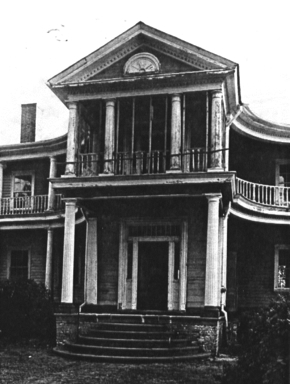
Southern Belle
Story by Richard Amrhine and Photos by Robert A. Martin
At Belle Grove, the cavalry arrived just in time. One the brink of collapse from years of neglect, the 18th –century plantation house has now been give new life, and is probably stronger today than it ever has been in its 210 years.
The property is known best as where James Madison, the fourth U.S. President was born in 1751. The land had been owned since 1670 by his mother’s side of the family, the Conways.
The house in which Madison was born is long gone, but what may be its foundation has been found on the grounds. Th existing house was built in the early 1790s. It lies ust off U.S.301 in the Port Conway area-named for the Conways-of southern King George County, across the Rappahannock River from Port Royal.
Over the years the house has been expanded time and again and its has been through cycles of neglect and renovation.
Belle Grove’s outlook sweetened when it was bought by Franz Haas Machinery in 1988. Haas, an Austrian company with office in Richmond, builds the equipment that makes waffle ice-cream cones an all sorts of wafers, cookies and crackers.
By the early 1990s, Haas realized that severe toll that time and weather were taking on the structure, and brought in contractors to save it. But that was only the beginning.
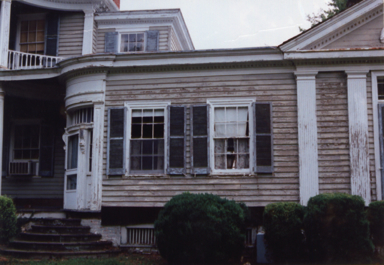
Old Materials, New Technology
The real restoration didn’t begin until 1997, when Haas called on Commonwealth Architects, a Richmond firm that specialize in recovering old buildings, to re-create the home inside and out.
“When we came in, we saw there were basic structural problems,” said Doug Harnsberger, who heads the firm. He said that before any renovation or expansion of the existing house could take pace, the porches, roofs, walls and floors had to be shored up.
Old materials, new technology
Throughout the renovation, modern technology was blended with original and period materials wherever possible. That was the challenge facing Tom Miller, the Richmond general contractor Commonwealth hired for the job. For example, rotting wooden columns were hollowed out and filled with an acrylic substance. The original outer shells were repaired and repainted. In the attic, strong new crossbeams were added to make sure the weight of the roof was spread evenly across loadbearing posts. The original 2-by-4 and 4–by-4 roof framing remains but looks rickety by today’s standards. The old slate roof was replaced with a copper one to reduce weight.
In addition, the electrical, plumbing, heating and air-conditioning systems had to be updated or added new. A buried geothermal system provides efficient, state-of-the-art climate control. Because Haas Machinery might use the house as a corporate retreat, it is wired for computers and video conferencing as well.
None of this work would be allowed to compromise the home’s historic value.
“Belle Grove is one of a few surviving 18-century heavy-timber frame dwellings in King George County that features such sophisticated qualities of Federal-era design and craftsmanship.” Harnsberger said.
Using tax credits
All of the work Commonwealth has done fell under the constraints of various regulatory agencies. The house is listed on both the state and national historic registers, and also qualified for state and federal historic rehabilitation tax credits.
Under National Park Service regulations, any additions would have to be distinct from the original structure, and any interior changes would have to be approved in advance.
Such was the case, Harnsberger said, when he determined that moving and enlarging interior doorways would create an open “cross-axis” across the rear of the home with archways at either end. Park service officials agreed that the change would enhance the future usefulness of the home and allowed it.
“The fine ‘character-defining’ features painstakingly restored at Belle Grove were made affordable by securing these rehab tax credits.” he said. “This project showcases the added value to the historic resource that the tax credits make affordable.”
One of the home’s longtime shortcomings had been the bathrooms. Small bathrooms that had been added to each end of the house were removed and replaced with larger modern ones that incorporate fixtures with the period décor.
Outside the park service has required that the siding on bathroom additions and their exterior trim be painted different colors than the rest of the house.
Aside from the governmental hoops through which Commonwealth had to maneuver, and its own judgments about what is or isn’t feasible or proper, it also has to account for the wishes an aesthetic concerns of the Haas family. That would seem justified in that the family has already spent, according to Harnsberger, $1.1 million on the exterior, $1.4 million on the interior and might be expecting to spend another $1 million at least on landscaping, a new swimming pool and any rehabilitation work on outbuildings that are falling apart.

Big picture, small details
Big picture, small details
To the layman this would seem to be an insurmountable task, but Harnsberger and his associate Susan Reed Smither, are somehow able to focus on each individual piece of the project while continually standing back to view their overall progress. They have to do that, they said, in order to satisfy the government, the owners and themselves.
One way they do that is by depending on Miller and his subcontractors, as well as suppliers who specialize in materials for historic renovations.
Harnsberger points out that one of the key elements of a historic renovation is mortar. It is often found deteriorated, but using a hard, concrete-based mortar will cause soft, old bricks to crumble because it won’t expand and contract with seasonal climate changes.
That issue has led Commonwealth to become fast friends with Jimmy Price of Virginia Lime Works in Lynchburg. He produces a softer, limestone-based mortar similar to that used originally in house like Belle Grove.
Part of what makes Belle Grove such an interesting architectural specimen is that it is the sum of so many parts. The original two-story house is basic, Federal center-hall design. The center hall was at first completed open, with the staircase against a shared wall in an adjacent room.
Later in the 1790s, symmetrical additions were made on either end of the house still in Federal style. In the 1840s, the house was expanded again, with Greek Revival-style symmetrical structures attached to each end. A rear porch facing the river was enlarged at the at time and some interior renovations were done.
Extensive work was done in the post-Civil War era, but not because the house was damaged during the hostilities. Remarkably, there is no evidence within the home’s walls that the house took any cannon or musket fire, according to Miller.
The grounds around the house because a staging area for Union troops gathering north of the Rappahannock. Directly across the river, Confederates were assembling. Legend has it that at night, under flags of truce, Yankee soldiers would trade coffee to the Rebels for their tobacco.
In the 1870s and 80s, the staircase was moved to the center hall and curved front walls and porches were added to the home’s land-facing façade. Curved doors were fashioned from single, large-trunked trees. No one involved with the project had ever seen such doors before.
Finally in the 1930s, the small symmetrical bathrooms were added to each end of the house. In keeping with the home’s layout the upstairs consists of a center hall with mirror-image master bedroom suites on either side, although one has been equipped with an elevator that runs to the basement.
The basement, which is now dry thanks to the renovation work, has a sauna, jet-bath and full bathroom. Adjacent rooms could be used as bedrooms, or as exercise or recreations areas.
Historic correctness
Smither said that all the interior paint colors were selected for their historic appropriateness in the Federal, Greek Revival and Colonial Revival areas of the home. Almost all were from Sherwin-Williams “Preservation Palette”.
The random-width heart pine flooring had to be lifted off and refitted after subflooring was repaired. That which was damaged beyond repair was replaced with floorboards designed to match.
All door and window frames, cornices, chair rail and other moldings were saved ad reinstalled when possible, replicated when necessary. A classically styled, discarded mantel was found in an outbuilding, restored and put back in place. The walls were replastered and the plaster ceiling medallions returned to their original beauty. The oldest portion of the house has most of its original imperfect window panes; those needing replacement came from salvage shops offering glass from the same period.
Altogether there are 7,200 finished square feet with 11 fireplaces (both wood and gas) and 11 full and half bathrooms. A new kitchen with top-of-the-line appliances has replaced the smaller, obsolete kitchen that was elsewhere in the house.
Haas owns the 600 acre Belle Grove property. The house itself sits on a 20-zcre parcel. There are large adjacent tracts of farmland. At one time, previous owner John Palmer Hooker bought a 45-acre parcel across the river to preserve the view from his rear porch and balcony. That land is apparently no longer part of the property.
